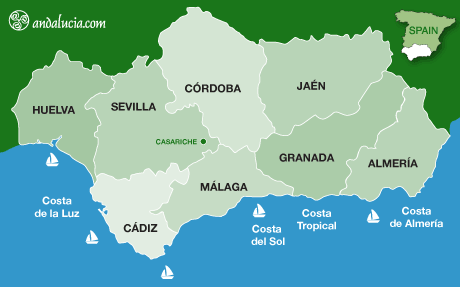CASARICHE
by Saskia Mier
Many important historical events have occurred in Casariche. There was, for example, a civil war between the citizens of Pompey and Cesar. And numerous archaeological remains have been found in the town, linking its origins back to Celtic times. It has about 5,500 inhabitants.
HISTORY
The town's origins date to the Celtiberians, when the city of Ventippo, was founded. The town passed into Roman possession and was the scene of the Second Civil War of the Roman Republic between two of the Latin triumvirs: Cneo Pompeyo Magno and Cayo Julio César.
During the Moorish period, the town was part of the Waliato de Estepa and was important for its location in the border area between the Arab and Christian Kingdoms. In 1241, the Almohads negotiated stipulations with King Alfonso X El Sabio, handing Estepa over to the Christians. The border area was transferred to the Order of Santiago in 1267. Casariche was now an Encomienda of Alfonso X El Sabio of Estepa.
Once the area was pacified after the conquest of the Nazari Kingdom of Granada in 1492, the defence of the Encomienda de Estepa by the Order of Santiago was no longer necessary. On 11 August 1559, after the abdication of the King, the Encomienda once again belonged to the Crown and on 12 August 1559 Infanta Doña Juana de Portugal finally sold it officially to Don Adán Centurión, Admiral of the Spanish squadron.
On 20 April 1564 the monarch Felipe II created the title of Marquesado de Estepa and granted it to Don Adán Centurión. Casariche was emancipated from the Marquesado in the last third of the eighteenth century. At the beginning of the nineteenth century, Casariche was characterised by the tranquillity of its streets and the affability of its inhabitants.
THINGS TO SEE
Iglesia de la Encarnación
The church dates to the last third of the seventeenth century and underwent reforms in the early nineteenth century and others more recently. The altarpiece that currently presides over the presbytery comes from the vanished Convent La Victoria in Estepa, with its decoration corresponding to that used in the second third of the eighteenth century. Located on Calle Virgen de la Encarnación.
Museo-Centro de Interpretación (Colección Museográfica del Mosaico Romano "José Herrera Rodas")
The Museum-Interpretation Centre in Casariche is newly built and has a detailed exhibition of Roman mosaics, as well as providing an insight into the history of the town. Located on Avenida de la Libertad.
Opening Times:
Tuesday-Saturday, 10:00-14:00hrs and 17:00-19:00hrs.
Sunday, 10:00-15:00hrs
Tel: 667 54 33 92
Biblioteca Municipal Marcos Ana
The municipal public library was inaugurated by Fernando Macarro Castillo himself, a poet and politician from Salamanca, whose pseudonym was "baptised" downtown in October 2009. It has several reading and study rooms, both for adults and children, and also an auditorium, as well as computers with internet connection. Located on Calle Andalucía.
THINGS TO SEE OUTSIDE THE VILLAGE
Ermita de San Marcos
The chapel was built in 1986 by several residents of Casariche, and the roof inside consists of the names of almost all the employees and workers who built it. Located in the Sierra del Puntal del Sur, about five kilometres from Casariche.
Yacimientos Arqueológicos
Casariche has various archaeological sites to visit: El Alcaparral, La Atalaya, Cerro Bellido, El Rigüelo, El Toril and El Almajar.
Cortijo Parejo
The farmhouse was built sometime before 1915, as there are indications that a reformation took place in 1915. It contains a nineteenth century garden, albeit poorly maintained, with large palm trees and bamboo plants. Located in Camino del Cortijo Parejo.
Cortijo Santa Bárbara
The farmhouse underwent major reforms in the nineteenth century, with a change of ownership, and during the twentieth century changes were made to adapt it to new uses, such as cereal cultivation and dog breeding. There are some remains of the primitive installations, such as the barn, main house, Roman pool and Moorish wheel, whereas other buildings have been renovated. It was built by Antonio Álvarez Sobrevila, "El Garlocho", at the beginning of the twentieth century. Located on Camino del Cortijo de Santa Bárbara.
Fuente El Almajar
The Almajar is a rich spring with remains of Roman ceramics and huge blocks of ashlar, possibly the remains of a tower placed there for the protection of the Roman road to Carteia. Located south-west of the village, off the A-379.
Hotels near Casariche
Book Hotels near Casariche
COUNTRYSIDE WALKS
Sendero Ribera del Río Yeguas
A footpath still in the development and construction phase, it runs along the Yeguas River, crossing Casariche. The route will go from the park on Avenida de la Libertad, south until the industrial estate of Fuente Arriba and link back to the starting point. Currently, the route is only for walkers but eventually will be available for use by cyclists as well.
GASTRONOMY
Traditional dishes in Casariche include encebollado de bacalao (cod in onion sauce), naranjas picas con bacalao (cod and orange), maimones (usually served as a soup with ham, egg and bread), salmorejo and cocido (meat stew). Sweet treats include roscos, pestiños and rosquitos fritos (all sweet pastries dipped in either sugar or honey).
HANDICRAFTS
The typical craft still produced in Casariche is esparto.
FESTIVALS
Cabalgata Reyes Magos
Three Kings procession celebrated on the evening of 5 January.
Fiesta de Candelaria
Celebrated on 2 February.
Día de Andalucía
Celebrated on 28 February.
Carnaval
Celebrated in February.
Semana Santa
Holy Week.
Romería de San Marcos
Celebrated on 25 April.
Romería de San Marcos
Celebrated on 15 May.
Velá de San Antonio
Celebrated on 13 June.
Feria de Santiago
Celebrated on 25 July.
Romanorum Festum Ventippo
Historical festival celebrated on the last weekend of August.
NEARBY PLACES
The neighbouring villages to Casariche are Badolatosa, Lora de Estepa and Puente Genil.

